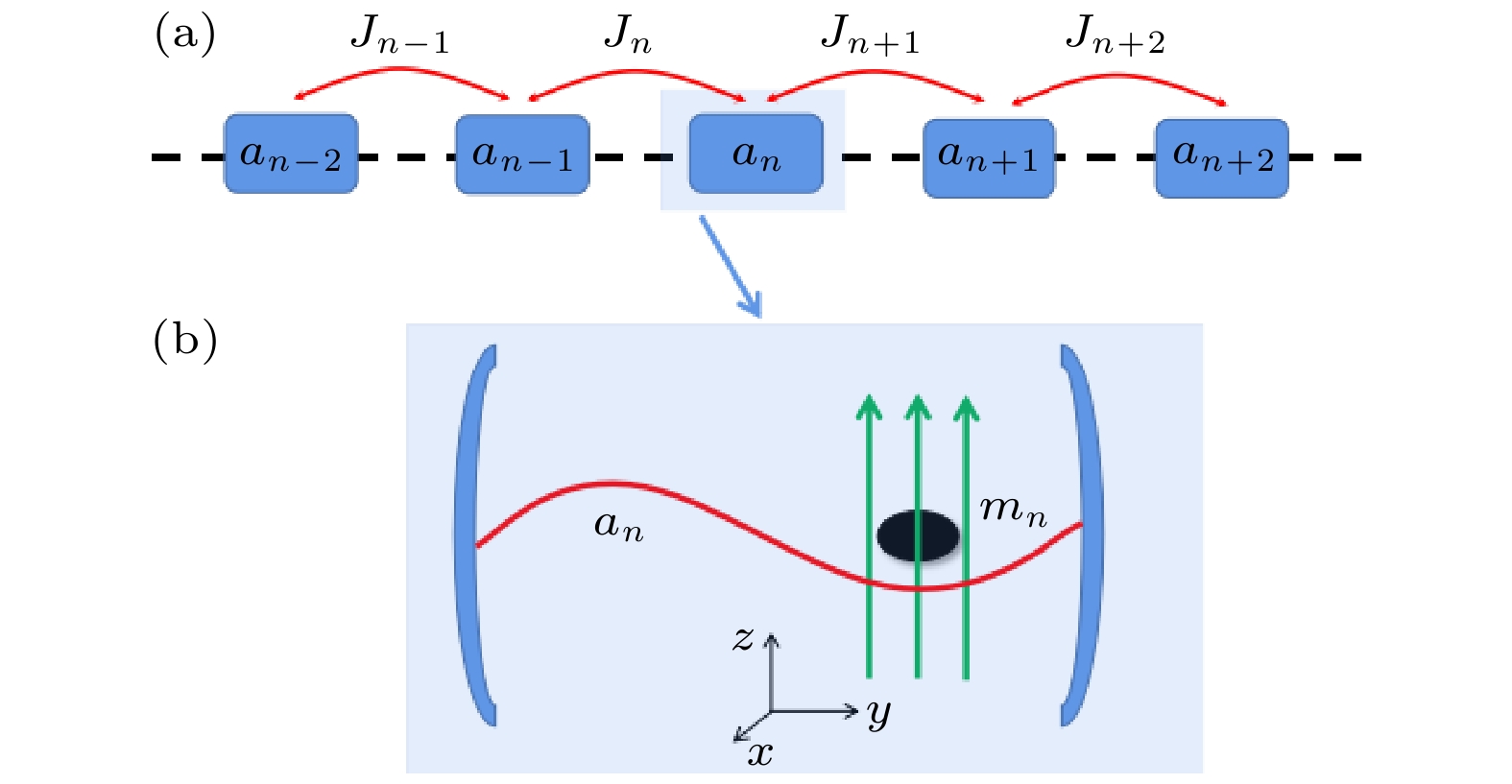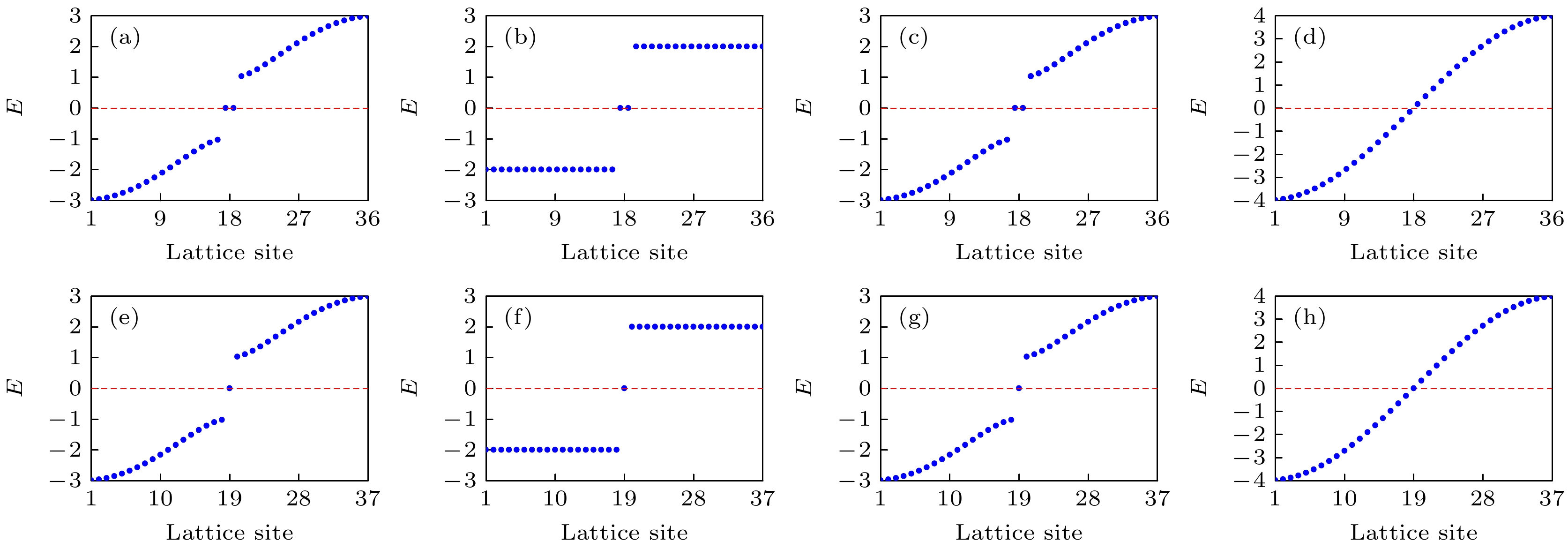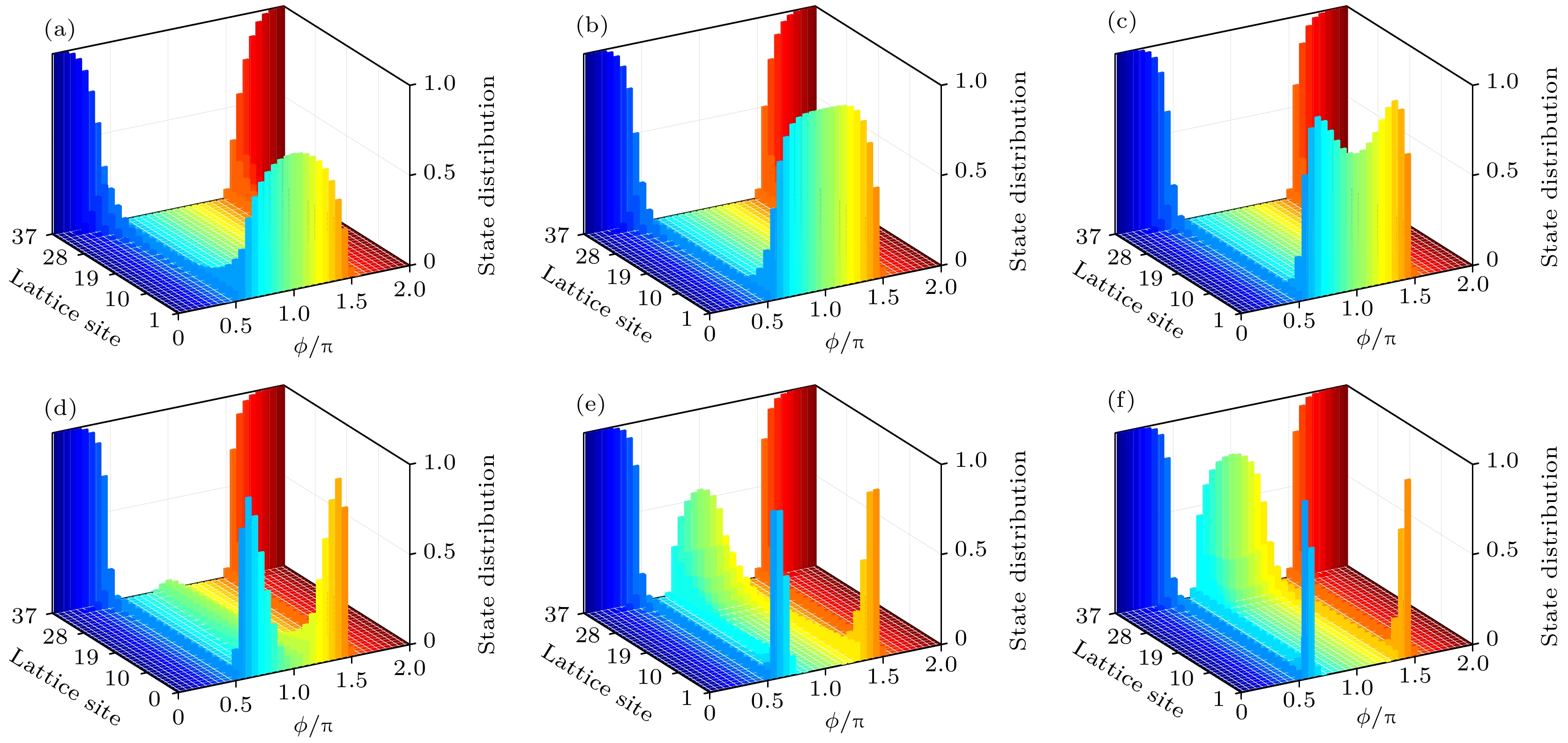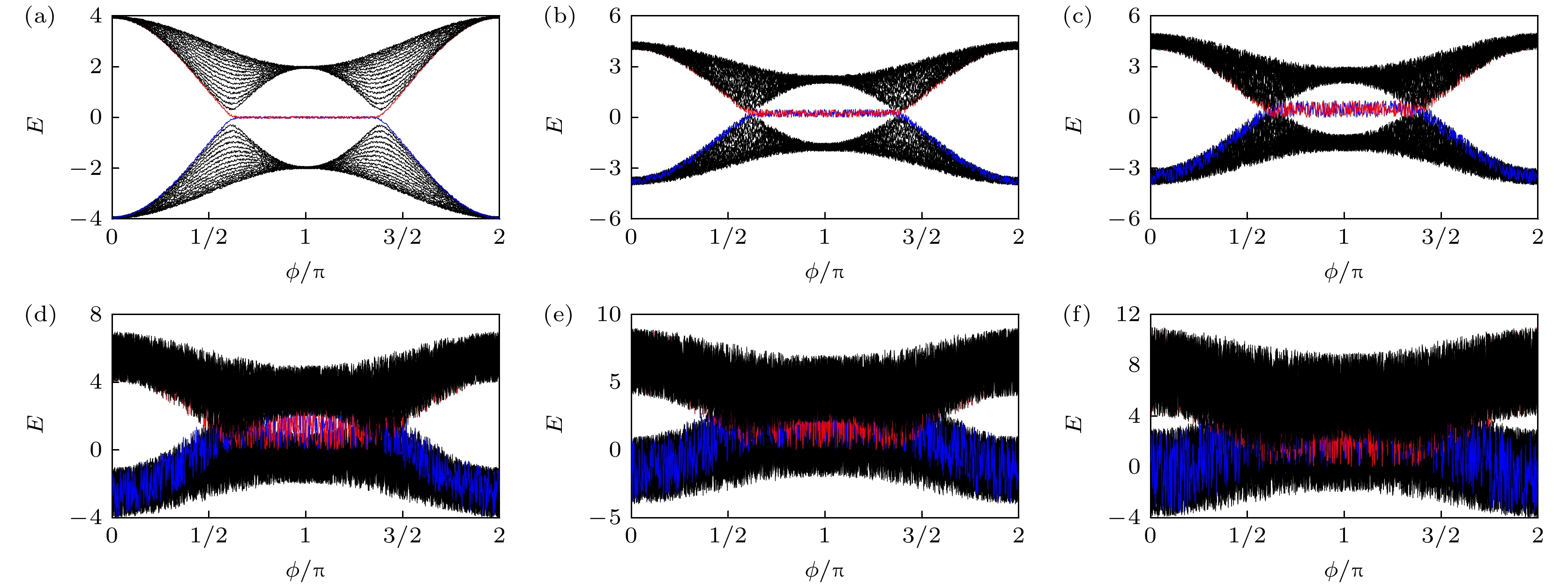-
We propose a theoretical scheme to study the topological properties of magnon-photon in a one-dimensional coupled cavity lattice. Each unit cell is composed of the cavity microwave photon and the magnon, where the magnon is placed inside the cavity. The coupling of cavity microwave photon and magnon is controlled by an external magnetic field, and multiple cavities are coupled with each other to form a one-dimensional coupled cavity lattice system. Here, we study the topological phase transition and topological quantum channels of magnon-photon in the system by adjusting the magnon-photon coupling. Firstly, considering odd and even number lattices, we analyze and discuss the energy spectrum and the edge state in one-dimensional coupled cavity lattices. It is found that the energy band of the system is symmetric, and the edge states in the energy gap have time reversal symmetry, which makes the system topologically protected. At the same time, it is also noted that the maximum value, flipping, and period of the energy spectrum have changed, and the region of the edge state has expanded and extended. In addition, the edge state distribution can undergo the flipping process, which can achieve multi-channel topological quantum state transmission. Besides, considering the presence of defects and disorder in the system, it is found that when the random defect potential is small, the edge state of the system is robust to it, but when the random defect potential is large, the fluctuation of the energy band will be enhanced, and the edge state will be submerged in the energy band. However, when the disorder is very small, it can cause band fluctuations and flipping phenomena, and the edge state is robust to it, indicating the topological protection of the edge state. This work offers an effective way to study topological magnon-photon, which will have promising applications in quantum information processing.
[1] Qi X L, Zhang S C 2011 Rev. Mod. Phys. 83 1057
 Google Scholar
Google Scholar
[2] Hasan M Z, Kane C L 2010 Rev. Mod. Phys. 82 3045
 Google Scholar
Google Scholar
[3] Bansil A, Lin H, Das T 2016 Rev. Mod. Phys. 88 021004
 Google Scholar
Google Scholar
[4] Chiu C K, Teo J C Y, Schnyder A P, Ryu S 2016 Rev. Mod. Phys 88 035005
 Google Scholar
Google Scholar
[5] Xu Z, Zhang Y, Chen S 2017 Phys. Rev. A 96 013606
 Google Scholar
Google Scholar
[6] Li L, Xu Z, Chen S 2014 Phys. Rev. B 89 085111
 Google Scholar
Google Scholar
[7] Li L, Chen S 2015 Phys. Rev. B 92 085118
 Google Scholar
Google Scholar
[8] Mei F, Zhu S L, Zhang Z M, Oh C H, Goldman N 2012 Phys. Rev. A 85 013638
 Google Scholar
Google Scholar
[9] Ge L, Wang L, Xiao M, Wen W, Chan C T, Han D 2015 Opt. Express 23 21585
 Google Scholar
Google Scholar
[10] Lin Y J, Compton R L, Jiménez-GarcÍa K, Porto J V, Spielman I B 2009 Nature 462 628
 Google Scholar
Google Scholar
[11] Jimenéz-GarcÍa K, LeBlanc L J, Williams R A, Beeler M C, Perry A R, Spielman I B 2012 Phys. Rev. Lett. 108 225303
 Google Scholar
Google Scholar
[12] Mei F, You J, Zhang D, Yang X C, Fazi R, Zhu S L, Kwek L C 2014 Phys. Rev. A 90 063638
 Google Scholar
Google Scholar
[13] Ganeshan S, Sun K, Das Sarma S 2013 Phys. Rev. Lett. 110 180403
 Google Scholar
Google Scholar
[14] Wray L A, Xu V, Xia Y, Hsieh D, Fedorov A V, SanHor Y, Cava R J, Bansil A, Lin H, Hasan M Z 2011 Nat. Phys. 7 32
 Google Scholar
Google Scholar
[15] Malki M, Uhrig G S 2017 Phys. Rev. B 95 235118
 Google Scholar
Google Scholar
[16] Mei F, You J B, Nie W, Fazio R, Zhu S L, Kwek L C 2015 Phys. Rev. A 92 041805
 Google Scholar
Google Scholar
[17] Mei F, Xue Z Y, Zhang D W, Tian L, Lee C, Zhu S L 2016 Quantum Sci. Technol. 1 015006
 Google Scholar
Google Scholar
[18] Cao J, Yi X, Wang H F 2020 Phys. Rev. A 102 032619
 Google Scholar
Google Scholar
[19] Stehle P 1970 Phys. Rev. A 2 102
 Google Scholar
Google Scholar
[20] Nathan M I, Fowler A B, Burns G 1963 Phys. Rev. Lett. 11 152
 Google Scholar
Google Scholar
[21] Haroche S, Kleppner D 1989 Phys. Today 42 24
 Google Scholar
Google Scholar
[22] Walther H, Varcoe B T, Englert B G, Becker T 2006 Rep. Prog. Phys. 69 1325
 Google Scholar
Google Scholar
[23] Wang Y P, Zhang Z C, Yu Y F, Zhang Z M 2019 Chin. Phys. B 28 014202
 Google Scholar
Google Scholar
[24] Huang S M, Agarwal G S 2010 Phys. Rev. A 81 033830
 Google Scholar
Google Scholar
[25] Wang Y P, Wang H 2023 Quantum Inf. Process. 22 386
 Google Scholar
Google Scholar
[26] Sanchez-Mondragon J J, Narozhny N B, Eberly J H 1983 Phys. Rev. Lett. 51 550
 Google Scholar
Google Scholar
[27] McConnell R, Zhang H, Hu J, Cuk S, Vuletic V 2015 Nature 519 439
 Google Scholar
Google Scholar
[28] Lukin M D 2003 Rev. Mod. Phys. 75 457
 Google Scholar
Google Scholar
[29] Zhang X F, Zou C L, Jiang L, Tang H X 2016 Sci. Adv. 2 e1501286
 Google Scholar
Google Scholar
[30] Tabuchi Y, Ishino S, Noguchi A, Ishikawa T, Yamazaki R, Usami K, Nakamura Y 2015 Science 349 405
 Google Scholar
Google Scholar
[31] 王振宇, 李志雄, 袁怀洋, 张知之, 曹云姗, 严鹏 2023 物理学报 72 057503
 Google Scholar
Google Scholar
Wang Z Y, Li Z X, Yuan H Y, Zhang Z Z, Cao Y S, Yan P 2023 Acta Phys. Sin. 72 057503
 Google Scholar
Google Scholar
[32] Zhang X, Zou C L, Jiang L, Tang H X 2014 Phys. Rev. Lett. 113 156401
 Google Scholar
Google Scholar
[33] Wang Y P, Zhang G Q, Zhang D, Luo X Q, Xiong W, Wang S P, Li T F, Hu C M, You J Q 2016 Phys. Rev. B 94 224410
 Google Scholar
Google Scholar
[34] Ren Y L, Xie J K, Li X K, Ma S L, Li F L 2022 Phys. Rev. B 105 094422
 Google Scholar
Google Scholar
[35] Xiao Y, Yan X H, Zhang Y, Grigoryan V L, Hu C M, Guo H, Xia K 2019 Phys. Rev. B 99 094407
 Google Scholar
Google Scholar
[36] Yu T, Yang H, Song L, Yan P, Cao Y 2020 Phys. Rev. B 101 144414
 Google Scholar
Google Scholar
[37] Cao Y, Yan P 2019 Phys. Rev. B 99 214415
 Google Scholar
Google Scholar
[38] Wang Y P, Zhang G Q, Zhang D, Li T F, Hu C M, You J Q 2018 Phys. Rev. Lett. 120 057202
 Google Scholar
Google Scholar
[39] Li J, Zhu S Y, Agarwal G S 2018 Phys. Rev. Lett. 121 203601
 Google Scholar
Google Scholar
[40] 刘浪, 王一平 2022 物理学报 71 224202
 Google Scholar
Google Scholar
Liu L, Wang Y P 2022 Acta Phys. Sin. 71 224202
 Google Scholar
Google Scholar
[41] 郑智勇, 陈立杰, 向吕, 王鹤, 王一平 2023 物理学报 72 244204
 Google Scholar
Google Scholar
Zheng Z Y, Chen L J, Xiang L, Wang H, Wang Y P 2023 Acta Phys. Sin. 72 244204
 Google Scholar
Google Scholar
[42] Wang W, Wang Y P 2022 Acta Phys. Sin. 71 194203 (in Chinese) [王伟, 王一平 2022 物理学报 71 194203]
 Google Scholar
Google Scholar
Wang W, Wang Y P 2022 Acta Phys. Sin.71 194203 (in Chinese) Google Scholar
Google Scholar
[43] Wang Y P, Wang W, Liu L, Zheng Z Y, Du M E 2022 Results Phys. 42 105999
 Google Scholar
Google Scholar
-
图 1 (a)一维耦合腔晶格模型图, $ J_{n} $是晶胞$ a_{n-1} $和$ a_{n} $之间的耦合; (b) $ a_n $和$ m_n $分别表示腔场和磁子的模式, 其中沿腔z 方向施加磁场H, 可以使磁子模式与腔场模式耦合
Fig. 1. (a) Schematic of the one-dimensional coupled cavity lattice system, $ J_{n} $ is the coupling strength between cavities $ a_{n-1} $ and $ a_{n} $; (b) $ a_n $ and $ m_n $ represent the modes of the cavity field and the magnon, an uniform bias magnetic field (H along the z direction) that establishes the magnon-photon coupling.
图 2 n = 36时, 系统能谱与相位$\phi $的关系图, 其中红色和蓝色线条是系统的两个边缘态模式 (a)$ g=0 $; (b)$ g=1 $; (c) $ g=2$; (d) $ g=3 $. 其他参数为$ J=1 $, $ \phi \in $[$ 0 $, $ 2 \pi $]
Fig. 2. Energy spectrum of the system via the phase $\phi $, the red and blue lines are the two edge state modes of the system at n = 36: (a) $ g=0 $; (b) $ g=1 $; (c) $ g=2 $; (d) $ g=3 $. Other parameters are set as $ J=1 $ and $ \phi \in $[$ 0 $, $ 2 \pi $].
图 3 $ n=37 $时, 系统能谱与相位$\phi $的关系图, 其中红色线条是系统零模边缘态 (a) $ g=0 $; (b) $ g=1 $; (c) $ g=2 $; (d) $ g= 3 $. 其他参数为$ J=1 $, $ \phi \in $[$ 0 $, $ 2 \pi $]
Fig. 3. Energy spectrum of the system via the phase $\phi $, the red line is the zero mode edge state of the system, n = 37 sites: (a) $ g=0 $; (b) $ g=1 $; (c) $ g=2 $; (d) $ g=3 $. Other parameters are set as $ J=1 $ and $ \phi \in $[$ 0 $, $ 2 \pi $].
图 4 系统能谱与晶格数关系图 (a)—(d) $ n=36 $, $ g=0, 1, 2, 3 $; (e)—(h) $ n=37 $, $ g=0, 1, 2, 3 $. 其他参数为$ J=1 $, $ \phi = \pi $
Fig. 4. Energy spectrum of the system via the lattice numbers: (a)–(d)$ n=36 $, $ g=0, 1, 2, 3 $; (e)–(h)$ n=37 $, $ g=0, 1, 2, 3 $. Other parameters are set as $ J=1 $ and $ \phi = \pi $.
图 6 边缘态概率分布与晶格数和相位$\phi $的关系图 (a) $ g=0 $; (b) $ g=1 $; (c) $ g=2 $; (d) $ g=3 $; (e) $ g=4 $; (f) $ g=5 $. 其他参数为$ n=37 $, $ J=1 $
Fig. 6. State distribution of edge state via the lattice numbers and the phase $\phi $: (a) $ g=0 $; (b) $ g=1 $; (c) $ g=2 $; (d) $ g=3 $; (e) $ g=4 $; (f) $ g=5 $. Other parameters are set as $ n=37 $ and $ J=1 $.
图 7 系统能谱与相位$\phi $和随机缺陷的关系图 (a) $ W_{{\mathrm{r}}}=0.1 $; (b) $ W_{{\mathrm{r}}}=0.5 $; (c) $ W_{{\mathrm{r}}}=1 $; (d) $ W_{{\mathrm{r}}}=3 $; (e) $ W_{{\mathrm{r}}}=5 $; (f) $ W_{{\mathrm{r}}}=7 $. 其他参数参考图2(b)
Fig. 7. Energy spectrum as a function of the phase $\phi $ for different degrees of defect: (a) $ W_{{\mathrm{r}}}=0.1 $; (b) $ W_{{\mathrm{r}}}=0.5 $; (c) $ W_{{\mathrm{r}}}=1 $; (d)$ W_{{\mathrm{r}}}=3 $; (e) $ W_{{\mathrm{r}}}=5 $; (f) $ W_{{\mathrm{r}}}=7 $. Other parameters are set as Fig. 2(b).
图 8 系统能谱与相位$\phi $和无序的关系图 (a) $ \delta=-0.3 $ (蓝色实线), $ \delta=0.3 $ (黑色虚线); (b)$ \delta=0.1 $ (蓝色实线), $ \delta=0.3 $ (黑色虚线); (c)$ \delta=-0.1 $ (蓝色实线), $ \delta=-0.3 $ (黑色虚线). 其他参数参考图2(b)
Fig. 8. Energy spectrum as a function of the phase $\phi $ for different degrees of disorder and the dissipation: (a) $ \delta=-0.3 $ (blue line), $ \delta=0.3 $ (black dotted line); (b) $ \delta=0.1 $ (blue line), $ \delta=0.3 $ (black dotted line); (c) $ \delta=-0.1 $ (blue line), $ \delta=-0.3 $ (black dotted line). Other parameters are set as Fig. 2(b).
-
[1] Qi X L, Zhang S C 2011 Rev. Mod. Phys. 83 1057
 Google Scholar
Google Scholar
[2] Hasan M Z, Kane C L 2010 Rev. Mod. Phys. 82 3045
 Google Scholar
Google Scholar
[3] Bansil A, Lin H, Das T 2016 Rev. Mod. Phys. 88 021004
 Google Scholar
Google Scholar
[4] Chiu C K, Teo J C Y, Schnyder A P, Ryu S 2016 Rev. Mod. Phys 88 035005
 Google Scholar
Google Scholar
[5] Xu Z, Zhang Y, Chen S 2017 Phys. Rev. A 96 013606
 Google Scholar
Google Scholar
[6] Li L, Xu Z, Chen S 2014 Phys. Rev. B 89 085111
 Google Scholar
Google Scholar
[7] Li L, Chen S 2015 Phys. Rev. B 92 085118
 Google Scholar
Google Scholar
[8] Mei F, Zhu S L, Zhang Z M, Oh C H, Goldman N 2012 Phys. Rev. A 85 013638
 Google Scholar
Google Scholar
[9] Ge L, Wang L, Xiao M, Wen W, Chan C T, Han D 2015 Opt. Express 23 21585
 Google Scholar
Google Scholar
[10] Lin Y J, Compton R L, Jiménez-GarcÍa K, Porto J V, Spielman I B 2009 Nature 462 628
 Google Scholar
Google Scholar
[11] Jimenéz-GarcÍa K, LeBlanc L J, Williams R A, Beeler M C, Perry A R, Spielman I B 2012 Phys. Rev. Lett. 108 225303
 Google Scholar
Google Scholar
[12] Mei F, You J, Zhang D, Yang X C, Fazi R, Zhu S L, Kwek L C 2014 Phys. Rev. A 90 063638
 Google Scholar
Google Scholar
[13] Ganeshan S, Sun K, Das Sarma S 2013 Phys. Rev. Lett. 110 180403
 Google Scholar
Google Scholar
[14] Wray L A, Xu V, Xia Y, Hsieh D, Fedorov A V, SanHor Y, Cava R J, Bansil A, Lin H, Hasan M Z 2011 Nat. Phys. 7 32
 Google Scholar
Google Scholar
[15] Malki M, Uhrig G S 2017 Phys. Rev. B 95 235118
 Google Scholar
Google Scholar
[16] Mei F, You J B, Nie W, Fazio R, Zhu S L, Kwek L C 2015 Phys. Rev. A 92 041805
 Google Scholar
Google Scholar
[17] Mei F, Xue Z Y, Zhang D W, Tian L, Lee C, Zhu S L 2016 Quantum Sci. Technol. 1 015006
 Google Scholar
Google Scholar
[18] Cao J, Yi X, Wang H F 2020 Phys. Rev. A 102 032619
 Google Scholar
Google Scholar
[19] Stehle P 1970 Phys. Rev. A 2 102
 Google Scholar
Google Scholar
[20] Nathan M I, Fowler A B, Burns G 1963 Phys. Rev. Lett. 11 152
 Google Scholar
Google Scholar
[21] Haroche S, Kleppner D 1989 Phys. Today 42 24
 Google Scholar
Google Scholar
[22] Walther H, Varcoe B T, Englert B G, Becker T 2006 Rep. Prog. Phys. 69 1325
 Google Scholar
Google Scholar
[23] Wang Y P, Zhang Z C, Yu Y F, Zhang Z M 2019 Chin. Phys. B 28 014202
 Google Scholar
Google Scholar
[24] Huang S M, Agarwal G S 2010 Phys. Rev. A 81 033830
 Google Scholar
Google Scholar
[25] Wang Y P, Wang H 2023 Quantum Inf. Process. 22 386
 Google Scholar
Google Scholar
[26] Sanchez-Mondragon J J, Narozhny N B, Eberly J H 1983 Phys. Rev. Lett. 51 550
 Google Scholar
Google Scholar
[27] McConnell R, Zhang H, Hu J, Cuk S, Vuletic V 2015 Nature 519 439
 Google Scholar
Google Scholar
[28] Lukin M D 2003 Rev. Mod. Phys. 75 457
 Google Scholar
Google Scholar
[29] Zhang X F, Zou C L, Jiang L, Tang H X 2016 Sci. Adv. 2 e1501286
 Google Scholar
Google Scholar
[30] Tabuchi Y, Ishino S, Noguchi A, Ishikawa T, Yamazaki R, Usami K, Nakamura Y 2015 Science 349 405
 Google Scholar
Google Scholar
[31] 王振宇, 李志雄, 袁怀洋, 张知之, 曹云姗, 严鹏 2023 物理学报 72 057503
 Google Scholar
Google Scholar
Wang Z Y, Li Z X, Yuan H Y, Zhang Z Z, Cao Y S, Yan P 2023 Acta Phys. Sin. 72 057503
 Google Scholar
Google Scholar
[32] Zhang X, Zou C L, Jiang L, Tang H X 2014 Phys. Rev. Lett. 113 156401
 Google Scholar
Google Scholar
[33] Wang Y P, Zhang G Q, Zhang D, Luo X Q, Xiong W, Wang S P, Li T F, Hu C M, You J Q 2016 Phys. Rev. B 94 224410
 Google Scholar
Google Scholar
[34] Ren Y L, Xie J K, Li X K, Ma S L, Li F L 2022 Phys. Rev. B 105 094422
 Google Scholar
Google Scholar
[35] Xiao Y, Yan X H, Zhang Y, Grigoryan V L, Hu C M, Guo H, Xia K 2019 Phys. Rev. B 99 094407
 Google Scholar
Google Scholar
[36] Yu T, Yang H, Song L, Yan P, Cao Y 2020 Phys. Rev. B 101 144414
 Google Scholar
Google Scholar
[37] Cao Y, Yan P 2019 Phys. Rev. B 99 214415
 Google Scholar
Google Scholar
[38] Wang Y P, Zhang G Q, Zhang D, Li T F, Hu C M, You J Q 2018 Phys. Rev. Lett. 120 057202
 Google Scholar
Google Scholar
[39] Li J, Zhu S Y, Agarwal G S 2018 Phys. Rev. Lett. 121 203601
 Google Scholar
Google Scholar
[40] 刘浪, 王一平 2022 物理学报 71 224202
 Google Scholar
Google Scholar
Liu L, Wang Y P 2022 Acta Phys. Sin. 71 224202
 Google Scholar
Google Scholar
[41] 郑智勇, 陈立杰, 向吕, 王鹤, 王一平 2023 物理学报 72 244204
 Google Scholar
Google Scholar
Zheng Z Y, Chen L J, Xiang L, Wang H, Wang Y P 2023 Acta Phys. Sin. 72 244204
 Google Scholar
Google Scholar
[42] Wang W, Wang Y P 2022 Acta Phys. Sin. 71 194203 (in Chinese) [王伟, 王一平 2022 物理学报 71 194203]
 Google Scholar
Google Scholar
Wang W, Wang Y P 2022 Acta Phys. Sin.71 194203 (in Chinese) Google Scholar
Google Scholar
[43] Wang Y P, Wang W, Liu L, Zheng Z Y, Du M E 2022 Results Phys. 42 105999
 Google Scholar
Google Scholar
计量
- 文章访问数: 4981
- PDF下载量: 165
- 被引次数: 0














 下载:
下载:







